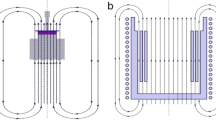Abstract
In this paper, the use of anisotropy of magnetic susceptibility (AMS) measurements has been investigated in order to check the sensitivity of this technique versus the flow conditions. The orientation of anisotropic magnetic particles during the flow of a polystyrene\(/\)magnetite blend through a capillary rheometer has been studied. Thanks to the magnetic properties of the magnetite, AMS measurements are possible. Different values of the filler concentration, viscosity, and shear rate were used. It is shown that the AMS technique is able to detect accurately particle orientation and that sensitivity decreases when increasing the concentration of magnetite grains. In addition, the rectangular-shaped sample imposed by the rheological device does not affect measures of AMS significantly. The results give reasons to consider that the measure of AMS is an accurate and sensitive method to access the mean local rheological behavior in filled or non-filled systems containing anisotropic tracers.








Similar content being viewed by others
References
Arbaret L, Fernandez A, Jezek J, Ildefonse B, Launeau P, Diot H (2000) Analogue and numerical modelling of shape fabrics: consequences for strain and flow determination in magmas. Trans R Soc Edinb Earth Sci 90:97–109
Bascou J, Camps P, Dautria JM (2005) Magnetic versus crystallographic fabrics in a basaltic lava flow. J Volcanol Geotherm Res 145:119–135
Bay RS, Tucker CL (1992) Fiber orientation in simple injection moldings. Part I: theory and numerical methods. Polym Compos 13:317–331
Bouchez JL (1997) Granite is never isotropic: an introduction to AMS studies of granitic rocks. In: Granite: from segregation of melt to emplacement fabrics. Kluwer Acad. Publ., pp 95–112
Cañón-Tapia E, Chávez-Álvarez M (2004) Theoretical aspects of particle movement in flowing magma: implication for the anisotropy of magnetic susceptibility of dykes and lava flows. In: Magnetic fabric methods and applications. Geological Society, London, Special Publications, London, pp 227–249
Dragoni M, Lanza R, Tallarico A (1997) Magnetic anisotropy produced by magma flow: theoretical model and experimental data from Ferrar dolerite sills (Antarctica). Geophys J Int 128:230–240
Dunlop DJ (2002) Theory and application of the Day plot (Mrs/Ms versus Hcr/Hc). 1. Theoretical curves and tests using titanomagnetite data. J Geophys Res 107:2002
Fanjat G, Camps P, Shcherbakov V, Barou F, Sougrati MT, Perrin M (2012a) Magnetic interactions at the origin of abnormal magnetic fabrics in lava flows: a case study from Kerguelen flood basalts. Geophys J Int 189:815–832
Fanjat G, Shcherbakov V, Camps P (2012b) Influence of magnetic interaction on the anisotropy of magnetic susceptibility: the keys of single domain particles packed in globule aggregates. Studia Geophysica et Geodaetica 56:751–768
Fernandez A, Feybesse JL, Mezure JF (1983) Theorical and experimental study of fabrics developed by different shaped markers in two-dimensional simple shear. Bull Soc Geol Fr 25:319–326
Giroud T (2001) Mesure et calcul des contraintes résiduelles dans les pièces injectées en thermoplastiques avec et sans fibres de renfort. Dissertation, Ecole des Mines de Paris
Grégoire V, Darrozes J, Gaillot P, Nédélec A (1998) Magnetite grain shape fabric and distribution anisotropy versus rock magnetic fabric: a 3D-case study. J Struct Geol 20:937–944
Gupta M, Wang KK (1993) Fiber orientation and mechanical properties of short fiber reinforced injection-molded composites: simulated and experimental results. Polym Compos 14:367–382
Hastie WW, Watkeys MK, Aubourg C (2011) Significance of magnetic and petrofabric in Karoo-feeder dykes, northern Lebombo. Tectonophysics 513:96–111
Hrouda F (1982) Magnetic anisotropy of rocks and its application in geology and geophysics. Geophys Surv 5:37–82
Jelinek V (1981) Characterization of the magnetic fabrics of rocks. Tectonophysics 79:63–67
Kaliske G, Seifert H (1975) The extend to which fibre breakdown can be influenced when injection molding glass fibre reinforced thermoplastics. Plaste U 22:739–746
Karpov V, Kaufman M (1965) Injection molding of glass reinforced nylon 66. Br Plast 38:498–506
Kenig S (1986) Fiber orientation development in molding of polymer composites. Polym Compos 7:50–55
Kratinová Z, Zavadá P, Hrouda F, Schulmann K (2006) Non-scaled analogue modelling of AMS development during viscous flow: a simulation on diapir-like structures. Tectonophysics 418:51–61
Le Meins JF, Moldeaners P, Mewis J (2003) Suspensions of monodispersed spheres in polymer melts: particle size effect in extensional flow. Rheologica Acta 42:184–190
Megally A (2005) Etude et Modélisation de l’orientation de fibres dans des thermoplastiques renforcés. Dissertation, Ecole des Mines de Paris
Rochette P, Jackson M, Aubourg C (1992) Rock magnetism and the interpretation of anisotropy of magnetic susceptibility. Rev Geophys 30:209–226
Tarling DH, Hrouda F (1993) The magnetic anisotropy of rocks. Chapman and Hall, London
Ventura G, De Rosa R, Mazzuoli R, Colletta E (1996) Deformation patterns in a high-viscosity lava flow inferred from the crystal preferred orientation and imbrication structures: an example from Salina (Aeolian Islands, southern Tyrrhenian Sea, Italy). Bull Volcanol 57:555–562
Vincent M, Agassant JF (1986) Experimental study and calculations of short glass fiber orientation in center gated molded disks. Polym Compos 7:76–83
Acknowledgments
Bernard Henry is thanked for assistance in the AMS measurements and Yannick Branquet for providing the first samples of magnetite grains used in our experiments. Authors would like to thank two anonymous reviewers for their constructive comments.
Author information
Authors and Affiliations
Corresponding author
Rights and permissions
About this article
Cite this article
Akkoyun, M., Majesté, JC. & Bascou, J. Using the anisotropy of magnetic susceptibility to infer flow-induced orientation of anisotropic particles: feasibility and sensitivity. Rheol Acta 52, 49–57 (2013). https://doi.org/10.1007/s00397-012-0670-6
Received:
Revised:
Accepted:
Published:
Issue Date:
DOI: https://doi.org/10.1007/s00397-012-0670-6




